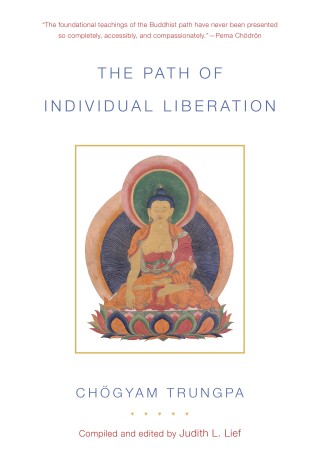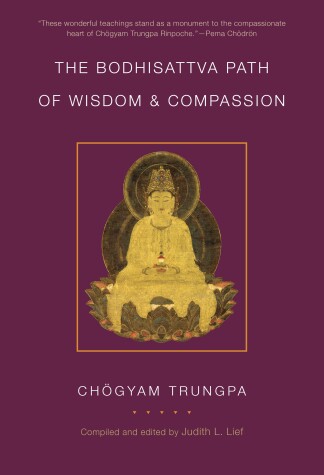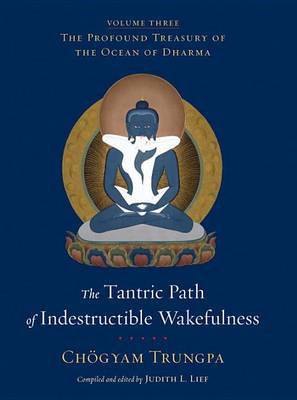The Profound Treasury of the Ocean of Dharma
3 primary works
Book 1
The foundational teachings of Buddhism—presented here in volume one of Chögyam Trungpa's magnum opus, which offers a systematic overview of the entire path of Tibetan Buddhism
This three-volume collection presents in lively, relevant language the comprehensive teachings of the Tibetan Buddhist path of the hinayana, mahayana, and vajrayana. Considered Chögyam Trungpa’s masterpiece, The Profound Treasury of the Ocean of Dharma will resonate with new and senior students of Buddhism.
Chögyam Trungpa begins his study by presenting the teachings of the hinayana. The hinayana introduces core Buddhist teachings on the nature of mind, the practice of meditation, the reality of suffering, and the possibility of liberation. It examines the nature of suffering, impermanence, and egolessness, with an emphasis on personal development through meditative discipline and study. The formal entry into the hinayana and the Buddhist path altogether is the refuge vow, in which a student goes for refuge to the Buddha, or the teacher; the dharma, or the teachings; and the sangha, or the community. The hinayana path is based on training in mindfulness and awareness, cultivating virtue, and cutting grasping.
Topics covered in detail in this volume include the four noble truths, karma, the four foundations of mindfulness, meditation practice, the refuge vows, the three jewels, the five skandhas, the five precepts, twofold egolessness, and more.
This three-volume collection presents in lively, relevant language the comprehensive teachings of the Tibetan Buddhist path of the hinayana, mahayana, and vajrayana. Considered Chögyam Trungpa’s masterpiece, The Profound Treasury of the Ocean of Dharma will resonate with new and senior students of Buddhism.
Chögyam Trungpa begins his study by presenting the teachings of the hinayana. The hinayana introduces core Buddhist teachings on the nature of mind, the practice of meditation, the reality of suffering, and the possibility of liberation. It examines the nature of suffering, impermanence, and egolessness, with an emphasis on personal development through meditative discipline and study. The formal entry into the hinayana and the Buddhist path altogether is the refuge vow, in which a student goes for refuge to the Buddha, or the teacher; the dharma, or the teachings; and the sangha, or the community. The hinayana path is based on training in mindfulness and awareness, cultivating virtue, and cutting grasping.
Topics covered in detail in this volume include the four noble truths, karma, the four foundations of mindfulness, meditation practice, the refuge vows, the three jewels, the five skandhas, the five precepts, twofold egolessness, and more.
Book 2
Chögyam Trungpa continues his study of the three “yanas” of Tibetan Buddhism with this overview of the teachings of the mahayana
This three-volume collection presents in lively, relevant language the comprehensive teachings of the Tibetan Buddhist path of the hinayana, mahayana, and vajrayana. Considered Chögyam Trungpa’s magnum opus, The Profound Treasury of the Ocean of Dharma will resonate with new and senior students of Buddhism.
In this second volume, Chögyam Trungpa presents the bodhisattva teachings of the mahayana. At this point—having trained and seen the benefits of looking within—the student begins to shift their focus outward to the broader world. Formal entry into the mahayana occurs with taking the bodhisattva vow. Mahayana practitioners dedicate themselves to the service of all sentient beings, aspiring to save them from sorrow and confusion, and vowing to bring them to perfect liberation. This stage of the path emphasizes the cultivation of wisdom through the view and experience of emptiness, or shunyata, in which all phenomena are seen to be unbounded, completely open, ungraspable, and profound. From the ground of shunyata, compassionate activity is said to arise naturally and spontaneously.
In addition to mindfulness and awareness, the mahayanist practices lojong, or "mind training," based on the cultivation of the paramitas, or "transcendent virtues": generosity, discipline, patience, exertion, meditation, and prajna, or "knowledge." As a component of lojong, tonglen, or "sending and taking," is practiced in order to increase maitri, or loving-kindness. Other topics covered in detail in this volume include bodhichitta, skillful means, Buddha nature and basic goodness, Madhyamaka, the ten bhumis, the three kayas, and more.
This three-volume collection presents in lively, relevant language the comprehensive teachings of the Tibetan Buddhist path of the hinayana, mahayana, and vajrayana. Considered Chögyam Trungpa’s magnum opus, The Profound Treasury of the Ocean of Dharma will resonate with new and senior students of Buddhism.
In this second volume, Chögyam Trungpa presents the bodhisattva teachings of the mahayana. At this point—having trained and seen the benefits of looking within—the student begins to shift their focus outward to the broader world. Formal entry into the mahayana occurs with taking the bodhisattva vow. Mahayana practitioners dedicate themselves to the service of all sentient beings, aspiring to save them from sorrow and confusion, and vowing to bring them to perfect liberation. This stage of the path emphasizes the cultivation of wisdom through the view and experience of emptiness, or shunyata, in which all phenomena are seen to be unbounded, completely open, ungraspable, and profound. From the ground of shunyata, compassionate activity is said to arise naturally and spontaneously.
In addition to mindfulness and awareness, the mahayanist practices lojong, or "mind training," based on the cultivation of the paramitas, or "transcendent virtues": generosity, discipline, patience, exertion, meditation, and prajna, or "knowledge." As a component of lojong, tonglen, or "sending and taking," is practiced in order to increase maitri, or loving-kindness. Other topics covered in detail in this volume include bodhichitta, skillful means, Buddha nature and basic goodness, Madhyamaka, the ten bhumis, the three kayas, and more.
Book 3
Chögyam Trungpa explores the the vajrayana teachings of the tantric path in this final volume of his masterpiece on Tibetan Buddhism
This three-volume collection presents in lively, relevant language the comprehensive teachings of the Tibetan Buddhist path of the hinayana, mahayana, and vajrayana. Considered Chögyam Trungpa’s magnum opus, The Profound Treasury of the Ocean of Dharma will resonate with new and senior students of Buddhism.
In this third and final volume, Chögyam Trungpa’s examines the vajrayana teachings of the tantric path. The vajrayana, or "diamond vehicle," also referred to as tantra, draws upon and extends the teachings of the hinayana and mahayana. As with the hinayana and the mahayana, the formal acceptance into the vajrayana is marked by a vow, in this case the samaya vow. There is an emphasis at this stage on the student-teacher relationship and on the quality of devotion. Generally, students must complete preliminary practices, called ngöndro, to prepare themselves for initiation into the vajrayana path before going further. Having done so, they then receive the appropriate empowerments to begin tantric practices. There are empowerment ceremonies of many kinds, called abhishekas. The vajrayana includes both form practices, such as visualizations and sadhanas (ritual liturgies), and formless practices based on allowing the mind to rest naturally in its inherent clarity and emptiness. Although on the surface, there is much greater complexity in tantric practices, the principles of mindfulness and awareness and the cultivation of compassion and skillful action continue to be of central importance.
The tantric path requires complete engagement and fierce dedication. It is said to be a more rapid path, but it is also more dangerous. There is a quality of directness, abruptness, and wholeheartedness. Tantrikas, or vajrayana practitioners, recognize that the most challenging aspects of life, the energies and play of confused emotions and frightening obstacles, can be worked with as gateways to freedom and realization. Other topics covered in detail in this volume include the four reminders, the mandala principle, mahamudra, atiyoga, and more.
This three-volume collection presents in lively, relevant language the comprehensive teachings of the Tibetan Buddhist path of the hinayana, mahayana, and vajrayana. Considered Chögyam Trungpa’s magnum opus, The Profound Treasury of the Ocean of Dharma will resonate with new and senior students of Buddhism.
In this third and final volume, Chögyam Trungpa’s examines the vajrayana teachings of the tantric path. The vajrayana, or "diamond vehicle," also referred to as tantra, draws upon and extends the teachings of the hinayana and mahayana. As with the hinayana and the mahayana, the formal acceptance into the vajrayana is marked by a vow, in this case the samaya vow. There is an emphasis at this stage on the student-teacher relationship and on the quality of devotion. Generally, students must complete preliminary practices, called ngöndro, to prepare themselves for initiation into the vajrayana path before going further. Having done so, they then receive the appropriate empowerments to begin tantric practices. There are empowerment ceremonies of many kinds, called abhishekas. The vajrayana includes both form practices, such as visualizations and sadhanas (ritual liturgies), and formless practices based on allowing the mind to rest naturally in its inherent clarity and emptiness. Although on the surface, there is much greater complexity in tantric practices, the principles of mindfulness and awareness and the cultivation of compassion and skillful action continue to be of central importance.
The tantric path requires complete engagement and fierce dedication. It is said to be a more rapid path, but it is also more dangerous. There is a quality of directness, abruptness, and wholeheartedness. Tantrikas, or vajrayana practitioners, recognize that the most challenging aspects of life, the energies and play of confused emotions and frightening obstacles, can be worked with as gateways to freedom and realization. Other topics covered in detail in this volume include the four reminders, the mandala principle, mahamudra, atiyoga, and more.


